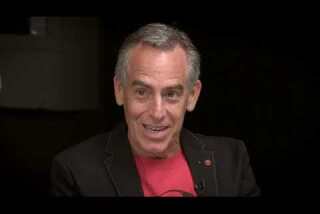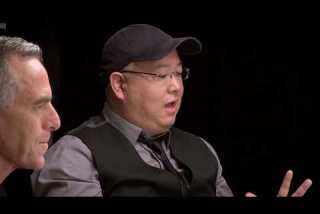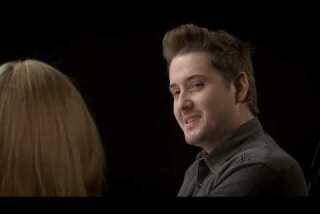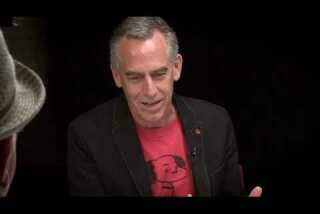The Envelope: Directors of five Oscar-contending animated features discuss realizing visions and casting voices

An animated gathering with, clockwise from top left, directors Richard Starzak, Pete Docter, Steve Martino, Duke Johnson and Peter Sohn.
- Share via
Five directors came together recently for The Envelope Animation Roundtable. In a conversation at the L.A. Times, Pete Docter (“Inside Out”), Duke Johnson (“Anomalisa”), Steve Martino (“The Peanuts Movie”), Peter Sohn (“The Good Dinosaur”) and Richard Starzak (“Shaun the Sheep Movie”) tackled such topics as selling their ideas, letting the visuals tell the story and working with voice actors.
See the most-read stories in Entertainment this hour >>
Here are excerpts from that conversation:
The Envelope Animation Roundtable


The Envelope Animation Roundtable

The Envelope Animation Roundtable | Steve Martino on keeping the 'Peanuts' legacy alive

The Envelope Animation Roundtable | Richard Starzak on creating a feature length 'Shaun the Sheep' story

The Envelope Animation Roundtable | Directors discuss casting their voice actors

The Envelope Animation Roundtable | Duke Johnson on choosing animation for 'Anomalisa'

The Envelope Animation Roundtable | Directors discuss career advice
Duke, you went out on Kickstarter and had to convince fans and the public that your idea was worth executing. What was that like?
Duke Johnson: [“Anomalisa”] was originally a play that was produced in 2005 at [UCLA’s] Royce Hall for two nights. It was called “Theater of the New Ear” and it was like a radio play, just actors sitting on stage reading scripts with foley. We approached Charlie [Kaufman] and said, “Can we do this?” And he said, “If you can get the money, you can do it.” So we went out and we approached a couple studios. And there was interest, but people wanted to develop it into something episodic or break it up into three parts. And we didn’t want to touch it. We wanted to preserve the original vision of the piece. So we tried Kickstarter and we raised $406,000, which isn’t enough money to make a stop-motion animated film. But it literally kick-started the process. So it was challenging in the sense that we didn’t have the money or the backing of a studio, but it was freeing in the sense that we didn’t have anybody looking over our shoulder and we could do creatively exactly what we wanted.
Steve, you had a really different challenge, which is that you had to persuade the Schulz family that you were the right guy for these characters.
Steve Martino: Craig Schulz [Charles’ son] talked to me about a feature film idea he had … working with his son, Bryan, who’s a screenwriter. He had something there that he felt the time was right. He wants to keep his father’s legacy alive for a new generation and I think he saw some of the work that we had done. I had worked on “Horton Hears a Who!,” which was based on Dr. Seuss. And he felt that we paid homage to that wonderful work, that book, and brought it to life on the screen in a way that felt true to the original material. And so that’s where our conversation started.... Thankfully, he wanted to work with us, wanted to work with me. I left that meeting excited like, “Oh my gosh, this is amazing!” And got home and told family and friends who were fans. And they were immediately excited and they’re like, “You better not screw it up.”
Richard, in your case “Shaun the Sheep” was a show before you proposed the idea of making it a feature film. How did you know that it had enough story to sustain a feature?
Richard Starzak: From very early on, strangely — because I devised the series. I came in to try and make “Shaun the Sheep” work. It was in development and it hadn’t been working very well mainly because they’d cast Shaun as a kind of hero that had a girlfriend, a love rival, and he could use cashpoint cards and he could take his girlfriend to the cinema, who was a pink sheep. And it made no sense to me whatsoever because there’s nowhere for the stories to go because … he had it all. So I kind of pushed it back to the idea of him being a sheep. He’s got a job; he eats grass. So a kind of Warner Bros. influence, really. I think it’s a Tex Avery cartoon where a sheep and a wolf go into the fields and they all clock in. [Editor’s note: The Ralph Wolf and Sam Sheepdog Looney Tunes characters were created by Chuck Jones.] It struck me that that was a better way to go, so we went that way. And also I decided on no dialogue because I’ve been a big fan of silent comedy and I thought, selfishly, this is my chance to do something that I want to do. I argued that that would actually be economically more viable and we could spend more time on the story and less on writing dialogue. But telling a story cinematically without dialogue was much more difficult than I thought.
Peter, your movie does a lot without dialogue too. How did you guys approach that?
Peter Sohn: Part of this movie is a survival story and taking a dinosaur out in the wilderness; there’s a lot of moments where he’s needing to figure out what to do on his own. And so there’s just inherently not a lot of dialogue with that. But then one of the original conceits to the story was the idea of a boy-and-dog story, but flipping it and making the traditional “boy” the dinosaur and the “dog” this little human boy; and then sticking true to that, where the dinosaur has evolved to speak a language but the little animal, the human boy, has no language whatsoever. And so in that relationship, there’s a lot of miscommunications.... We still have dialogue in our movie. There are just moments there that we’ve kind of relied on that type of silent comedies that we all so love.
Pete Docter: I don’t know about you guys, this maybe started on “Wall-E,” which, of course, didn’t have much dialogue either, but we started just trying a pass at the stories. If the dialogue wasn’t there, would you still be able to tell what’s going on? On “Up” we did this little montage at the beginning where we slowly just stripped away the dialogue and found it actually worked even better. So I think hopefully the films make sense on some level visually that you should be able to track them even if there’s no talking.
Let’s talk about casting your voice actors. Pete, did you have your characters before your voices?
Docter: We did. And that was really one of the keys for me. The concept was intriguing because of the fun that we could have with these broad characters and that’s what I feel animation does really well. And some of them — like I would use Lewis Black as an example of the fun we will have with casting when we get there, so I had him kind of in mind. But other ones like Amy Poehler were cast well, well after the character was built. We were starting even in some animation before we finally locked in on what she was really all about. And, of course, she helped enormously. And then, for us, we record before we animate. And so what inevitably happens is you bring your actor in and you look at the script and you go, “I need to change all this because this actor uses these kind of words and speaks with this cadence.” And so I end up rewriting almost everything just listening to the actors. They become an integral part of those characters that then the animators listen to as they create their expressions, the performances.
Duke, how did it work on your film?
Johnson: There’s three voices. The actors are David Thewlis and Jennifer Jason Leigh and Tom Noonan. And they were the same original three actors that were in the stage performance in 2005. And, actually, Charlie had written the script for the stage performance and then rehearsed with those actors for a week and, same thing, adjusted to their cadences and things that they added. And so the script was adapted to them for that performance. So they came in, the very first thing we did was record the actors before any character design, before any conversations about look or creative development. And we recorded them together, the three of them literally together at the same time straight through the script as if it were a stage performance. It was very intimate. But we wanted to have them reacting to each other and overlapping each other and that was very important to us. So we sort of recorded the movie first and the emotional effect that it had on us influenced everything after that. The aesthetic and the design came out of that experience.
Steve, when you’re casting all those kids — kids’ voices change even if they’re not going through puberty. So how did you approach that?
Martino: Normally, the way we work as we’re developing the story, we often will use — we call it scratch voices, people at the studio who will just do the voices as we’re shaping the story. But I did that once and it doesn’t sound right at all — to hear an adult voice being Charlie Brown or Linus. So we got into casting much earlier than we do on other productions. And, to me, the original specials — the Christmas special and Halloween special — those were the characters. Those voices imprinted on my mind and I thought, “You know, if I create a film and the voice doesn’t sound like that, as a fan I’d be like, ‘Oh, well, that’s not Charlie Brown. That’s not Linus.’” So our casting challenge was to find that quality of voice and, yet, what you want are kids to be real. Because the best takes, the best performance is that nobody puts on a voice. And I was so worried about finding a Linus because the original Linus has this beautiful little lisp. And I’m picturing myself being in a recording studio with a kid trying to act a lisp. And I’m like that’s going to be so fake and it’s not going to work. But we found Alex Garfin, this wonderful child actor who’s got this natural lisp. I tell you, we wrapped the movie and he came to Blue Sky to watch the full film. And as he walked around the studio, all the animators were like, “Just say something! Say ‘Charlie Brown!’” And just to have him say anything it was like, “Oh, my God, he sounds like Linus!”
Duke, your movie’s unique at this table because it’s —
Johnson: Not for children.
[Laughter]
— very specifically made for adults. It has adult language. There’s a sex scene in it. How do you think about using animation, which, in this country, people associate with family films?
Johnson: That concept that this medium is sort of for children has been and continues to be a bit of a challenge for us. We said early on that animation is a medium and not a genre. You can paint in various mediums and you can tell a story in many different ways. And so what does this medium bring to this story? How does the form match the content? We felt that it added a soulfulness and a dreamlike quality that we were looking for in this story and, also, it allowed us to examine the human experience and human interaction in a unique way. Because when you’re watching something animated, as an audience member you’re very conscious — or maybe subconsciously aware that everything is a choice. Every movement, every nuance, is a decision that somebody made. And that allows you to focus on it in a new way and it gives a certain amount of importance to details that might otherwise be mundane in a live-action film.
What are some of the difficulties of stop-motion, Richard?
Starzak: There’s a lot of problem-solving to do, which can be very cheeky. We had a scene in the restaurant where I wanted life outside the windows; I said, “I want some cars going past and some people walking past — it’s got to look like a city.” And the production manager actually said, “We’ve completely run out of puppets. No cars, no puppets. They’re all being used.” Everyone was on the set so I was trying to find a solution to make it look busy outside. Then one of the animators, who’s a motorcyclist, he picked up his crash helmet and he pushed it past the window and said, “It looks like a Honda Civic!” “We’ll shoot it! Get some more crash helmets!” We got these crash helmets going outside. It’s not a big shot, but you kind of have a nice little chuckle to yourself when you manage to get — the things you can get away with.
If you were talking to a version of yourself who was in college or art school, what kind of advice would you give that person?
Starzak: Blimey, that’s a tough question. I’d probably say, “Take up accountancy or something.”
Johnson: I went to undergrad film school and I graduated and I’m 21 years old and I felt a sense of urgency, like Orson Welles made “Citizen Kane” when he was 24, I have to write the great American screenplay and make the greatest movie ever made today. What am I going to do? And I’m a waiter at a restaurant.... I think that if you can stay in the moment, and watch movies and read books, and discover your tastes and who you are and what you like, and spend time doing that and experiencing life, and working on films or finding other creative people to collaborate with — as long as you keep that intention and you’re headed in that direction, it’s going to happen. You don’t have to be in a constant state of panic for 10 years.
Starzak: If I could speak to myself as a young person I’d say, “You’re better than you think you are. Just find out more. Just learn more. Just educate yourself more and understand how the process works.”
Docter: There’s this tendency to think that some people are just born talented, like it’s a magic ability. You would never hand a kid a violin and go, “Here, kid, this is a violin. You’re playing at Carnegie Hall tonight because you have natural talent.” That doesn’t happen. I think filmmaking is the same way. You need to practice. You need to get in there and start doing it — and some people have unfair talent.
Martino: So often I look at artwork that I created when I was a kid, and I would get to a certain point and then I would compare what I’m doing to the best that was there. And I would freeze like, “Oh, it’s no good.” And I wouldn’t stay committed to the process of continuing. I would stop and I would have these half-finished works because I got too critical of myself and didn’t trust that my instincts in the process of working on it would actually lead somewhere. And it’s taken me years to actually try to trust that.
More to Read
From the Oscars to the Emmys.
Get the Envelope newsletter for exclusive awards season coverage, behind-the-scenes stories from the Envelope podcast and columnist Glenn Whipp’s must-read analysis.
You may occasionally receive promotional content from the Los Angeles Times.











